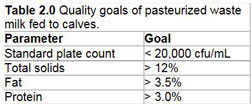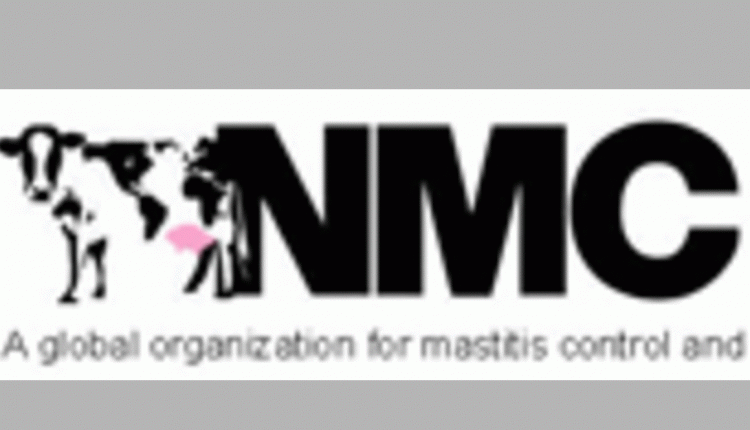The information below has been supplied by dairy marketers and other industry organizations. It has not been edited, verified or endorsed by Hoard’s Dairyman.  Pasteurized whole milk is one of many strategies used to supply the liquid diet of growing calves. This whole milk can be sourced from several different areas of any given dairy operation, including saleable bulk tank milk, transition milk, mastitic milk and other non-saleable antibiotic-containing milk. While feeding saleable bulk tank milk to calves usually results in an economic loss to the producer, pasteurizing and feeding non-saleable milk — essentially waste milk — can be an effective, cost-efficient method for utilizing an otherwise unusable product, provided it can be managed properly.
Pasteurized whole milk is one of many strategies used to supply the liquid diet of growing calves. This whole milk can be sourced from several different areas of any given dairy operation, including saleable bulk tank milk, transition milk, mastitic milk and other non-saleable antibiotic-containing milk. While feeding saleable bulk tank milk to calves usually results in an economic loss to the producer, pasteurizing and feeding non-saleable milk — essentially waste milk — can be an effective, cost-efficient method for utilizing an otherwise unusable product, provided it can be managed properly.

How pasteurization works
 A primary concern when feeding waste milk to calves is the bacterial load that may be present in the milk. Pasteurizing waste milk has been recommended in order to reduce bacterial contamination and limit the spread of diseases that can be transmitted through milk. Pasteurization is a method of exposing this waste milk to specific temperatures for specific amounts of time in order to reduce the pathogen load. Table 1.0 lists the temperature and time guidelines set forth for adequate pasteurization.
A primary concern when feeding waste milk to calves is the bacterial load that may be present in the milk. Pasteurizing waste milk has been recommended in order to reduce bacterial contamination and limit the spread of diseases that can be transmitted through milk. Pasteurization is a method of exposing this waste milk to specific temperatures for specific amounts of time in order to reduce the pathogen load. Table 1.0 lists the temperature and time guidelines set forth for adequate pasteurization.
Types of pasteurizers
Batch pasteurization uses a vat or tank with a heating element that heats the milk. Agitators are used with batch pasteurization to eliminate cold spots within the tank. This system typically heats the milk for longer periods of time at lower temperatures, as compared to high-temperature short-time units. Thereafter, milk is cooled and can be fed to calves.
Advantage:
Advantages:
The benefits of feeding pasteurized waste milk
Reduced disease transmission: Heating milk to 162 degrees Fahrenheit for 15 seconds is effective at eliminating Staphylococcus, Streptococcus, Salmonella, E. Coli, Listeria, Mycobacterium paratuberculosis (the organism responsible for Johnes disease) and Mycoplasma bacterium. Reducing bacterial exposure to calves can lower morbidity and mortality rates while also reducing the opportunity for pathogens to spread throughout a calf barn.
Utilization of waste milk: Unless fed to calves, waste milk is seen as a loss to dairy producers. Utilizing waste milk to feed and raise calves allows for producers to avoid potential economic losses, disposal challenges and environmental concerns that may arise during the discarding process. The profitability of a pasteurization system is dependent upon many factors, including labor, equipment, installation, maintenance, energy costs, number of calves, amount of waste milk available and other variable costs.
Opportunity for improved calf health and performance: Pasteurized waste milk tends to contain more protein and fat on a dry matter basis as compared to a traditional milk replacer, making it more energy-dense. Research has shown that pasteurized-milk-fed calves typically outperform milk-replacer-fed calves, due to the increased nutrient composition and non-specific immune components (e.g. hormones, growth factors, etc.) found in waste milk.
The drawbacks of feeding pasteurized waste milk
Intensive management: Compared to a milk replacer feeding program, feeding pasteurized milk to calves requires thorough research on what type of pasteurization system is most suited for the farm prior to purchase. Infrastructure needs to be considered in order to properly harvest, store and transport both pre- and post-pasteurized milk, to avoid contamination and reduce pathogen load. Strict pasteurization, sanitation, maintenance and monitoring protocols need to be set up and strictly followed.
Failure of pasteurization: Routine monitoring of the system is vital to ensure that failure of pasteurization is avoided. Pasteurization failure can occur due to a number of causes, including human error, malfunctioning and/or contaminated equipment, heating and cooling inadequacies or unusually high bacteria counts in the pre-pasteurized milk. If fed to calves, improperly pasteurized milk can quickly lead to calf morbidity and mortality.
Inadequate waste milk supply: Due to the inconsistent and sometimes unpredictable number of cows producing waste milk and the number of calves feeding on milk at any one time, there may be times when the supply of waste milk available for all calves is inadequate. As such, it is imperative to have a strategy in place in the case that waste milk supply may be limited. Options available to surpassing milk shortages include utilizing a milk replacer, using a milk extender or pasteurizing saleable milk. Older calves are more tolerant of diet changes than young calves. A common suggestion is to switch the diet of older calves during waste milk shortages, with the goal of limiting diet changes as much as possible in order to avoid digestive upset.
 Unlike milk replacer, the nutrient composition of waste milk is variable. This inconsistency has the ability to cause digestive upset in calves, especially in young calves. The suggested quality goals of pasteurized waste milk are found in Table 2.0. Milk replacer, fat supplements, whey proteins or milk balancer can be used to increase components. Pasteurized milk with high bacterial counts should never be fed to calves in the event of inadequate waste milk quality.
Unlike milk replacer, the nutrient composition of waste milk is variable. This inconsistency has the ability to cause digestive upset in calves, especially in young calves. The suggested quality goals of pasteurized waste milk are found in Table 2.0. Milk replacer, fat supplements, whey proteins or milk balancer can be used to increase components. Pasteurized milk with high bacterial counts should never be fed to calves in the event of inadequate waste milk quality.
There is no ‘one-size-fits-all’ option when it comes to selecting a liquid feeding program for growing calves. Major factors to consider when establishing a program should include targets for nutrient intake in relation to growth goals, ease of managing the program, economics and potential disease risks.
Jorgensen, M., and P. Hoffman. 2015. On-farm pasteurization of milk for calves. University of Wisconsin Dairy Update. https://fyi.uwex.edu/heifermgmt/files/2015/02/pasteurization.pdf.
US Department of Agriculture, Bovine Alliance on Management and Nutrition. 2008. Managing a pasteurizer system for feeding milk to calves. AFIA Publications, Arlington, VA.
US Department of Agriculture, Bovine Alliance on Management and Nutrition. 2008. Feeding pasteurized milk to dairy calves. AFIA Publications, Arlington, VA.

It is important to note that pasteurization is not a sterilization technique. Recent research has demonstrated that any remaining bacteria in pasteurized milk has the ability to proliferate to dangerous levels if holding temperature and/or feeding time is mismanaged. Additionally, pasteurizing highly contaminated milk may allow certain varieties of viable pathogenic bacteria to survive the pasteurization process.
Types of pasteurizers
Batch pasteurization uses a vat or tank with a heating element that heats the milk. Agitators are used with batch pasteurization to eliminate cold spots within the tank. This system typically heats the milk for longer periods of time at lower temperatures, as compared to high-temperature short-time units. Thereafter, milk is cooled and can be fed to calves.
Advantage:
- Low-cost
- Large batches may take several hours to pasteurize
- Manual cleaning process
Advantages:
- Rapid pasteurization
- Cleaning process may be automated, using a system similar to that used in milking systems
- Expense
- Requires an adequate supply of hot water
The benefits of feeding pasteurized waste milk
Reduced disease transmission: Heating milk to 162 degrees Fahrenheit for 15 seconds is effective at eliminating Staphylococcus, Streptococcus, Salmonella, E. Coli, Listeria, Mycobacterium paratuberculosis (the organism responsible for Johnes disease) and Mycoplasma bacterium. Reducing bacterial exposure to calves can lower morbidity and mortality rates while also reducing the opportunity for pathogens to spread throughout a calf barn.
Utilization of waste milk: Unless fed to calves, waste milk is seen as a loss to dairy producers. Utilizing waste milk to feed and raise calves allows for producers to avoid potential economic losses, disposal challenges and environmental concerns that may arise during the discarding process. The profitability of a pasteurization system is dependent upon many factors, including labor, equipment, installation, maintenance, energy costs, number of calves, amount of waste milk available and other variable costs.
Opportunity for improved calf health and performance: Pasteurized waste milk tends to contain more protein and fat on a dry matter basis as compared to a traditional milk replacer, making it more energy-dense. Research has shown that pasteurized-milk-fed calves typically outperform milk-replacer-fed calves, due to the increased nutrient composition and non-specific immune components (e.g. hormones, growth factors, etc.) found in waste milk.
The drawbacks of feeding pasteurized waste milk
Intensive management: Compared to a milk replacer feeding program, feeding pasteurized milk to calves requires thorough research on what type of pasteurization system is most suited for the farm prior to purchase. Infrastructure needs to be considered in order to properly harvest, store and transport both pre- and post-pasteurized milk, to avoid contamination and reduce pathogen load. Strict pasteurization, sanitation, maintenance and monitoring protocols need to be set up and strictly followed.
Failure of pasteurization: Routine monitoring of the system is vital to ensure that failure of pasteurization is avoided. Pasteurization failure can occur due to a number of causes, including human error, malfunctioning and/or contaminated equipment, heating and cooling inadequacies or unusually high bacteria counts in the pre-pasteurized milk. If fed to calves, improperly pasteurized milk can quickly lead to calf morbidity and mortality.
Inadequate waste milk supply: Due to the inconsistent and sometimes unpredictable number of cows producing waste milk and the number of calves feeding on milk at any one time, there may be times when the supply of waste milk available for all calves is inadequate. As such, it is imperative to have a strategy in place in the case that waste milk supply may be limited. Options available to surpassing milk shortages include utilizing a milk replacer, using a milk extender or pasteurizing saleable milk. Older calves are more tolerant of diet changes than young calves. A common suggestion is to switch the diet of older calves during waste milk shortages, with the goal of limiting diet changes as much as possible in order to avoid digestive upset.
Inconsistent nutrient composition:

There is no ‘one-size-fits-all’ option when it comes to selecting a liquid feeding program for growing calves. Major factors to consider when establishing a program should include targets for nutrient intake in relation to growth goals, ease of managing the program, economics and potential disease risks.
Sources:
Elizondo-Salazar, J. A., C. M. Jones, and A. J. Heinrichs. 2010. Evaluation of calf milk pasteurization systems on 6 Pennsylvania dairy farms. J. Dairy Sci. 93:5509-5513.
Elizondo-Salazar, J. A., C. M. Jones, and A. J. Heinrichs. 2010. Evaluation of calf milk pasteurization systems on 6 Pennsylvania dairy farms. J. Dairy Sci. 93:5509-5513.
Jorgensen, M., and P. Hoffman. 2015. On-farm pasteurization of milk for calves. University of Wisconsin Dairy Update. https://fyi.uwex.edu/heifermgmt/files/2015/02/pasteurization.pdf.
US Department of Agriculture, Bovine Alliance on Management and Nutrition. 2008. Managing a pasteurizer system for feeding milk to calves. AFIA Publications, Arlington, VA.
US Department of Agriculture, Bovine Alliance on Management and Nutrition. 2008. Feeding pasteurized milk to dairy calves. AFIA Publications, Arlington, VA.


